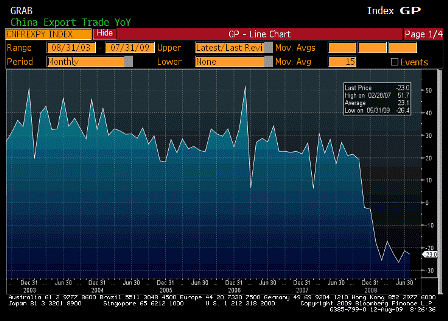Bean does see the interest rate channel but misses the savings/income channel, and has it all wrong regarding the fact that causation runs from loans to deposits and reserves, not from reserves to loans. And he’s reading what happened in Japan incorrectly as well.
Also, the second article misses the point as well. The rising domestic savings/debt pay downs is being ‘funded’ by govt. deficit spending. The deficit spending, if sufficient, allows the consumer to both increase savings and spending. So the fact that savings went up says nothing about what consumption might have done.
Bean Says Impact of BOE Bond Purchases ‘Moderately Encouraging’
August 25 (Bloomberg) — “The initial responses in the United Kingdom to these measures (purchases of government and corporate debt) have been moderately encouraging,” BOE Deputy Governor Charles Bean said in a speech. Gilt yields “appear to be some 50 to 75 basis points lower than they would otherwise be. And there are also signs of beneficial effects on conditions in the relevant corporate credit markets.” “It is very early to draw conclusions on the efficacy of these measures, as the transmission lags through to nominal spending are likely to be quite long,” Bean said. “When banks are trying to de-leverage, ,such additional reserves are more likely to be hoarded” Bean said. “That appears to be what happened during the Japanese experiment with quantitative easing in the early part of this decade and a similar response is to be expected from banks at the current juncture.”
U.K. Home Lending Drops as Consumers Cut
August 25 (Bloomberg) — U.K. net mortgage lending slumped to the lowest in almost nine years as consumers used gains from lower interest rates to pay down debt rather than boost spending.
“It could be that people on low interest rates are keeping their mortgage payments the same to reduce their borrowing,â€
Vicky Redwood, an economist at Capital Economics Ltd. said.
“It’s good news if you think consumers have taken on too much debt, but it’s bad news for the economy in the short term, as it means that money is not feeding back into the economy in increased spending.â€
Net mortgage lending at the end of July declined 74 % to 1.64 billion pounds ($2.69 billion) from 6.23 billion pounds in August 2007, the peak of Britain’s decade-long real estate boom, the British Bankers’ Association said yesterday. Mortgage approvals in July rose to the highest since February 2008. The data show new home lending is being outweighed by repayments, according to the BBA.
U.K. consumers’ debt reached a record 1.5 trillion pounds in January, according to the Bank of England. Consumer spending accounts for about 65 % of gross domestic product, while about 20 % of incomes are spent on mortgages, according to Simon Willis, an analyst at NCB Stockbrokers Ltd. in London.
“The household sector is far too highly leveraged,†said Ross Walker, economist at Royal Bank of Scotland Group Plc.
“There’s been a concerted effort to pay back credit cards and mortgages.â€
U.K. Rate of Workless Households Increases to Highest in Decade
August 26 (Bloomberg) — The proportion of workless households rose to the highest in a decade in the second quarter as Britain experienced its worst recession in a generation.
The rate increased 1.1 %age points from a year earlier to 16.9 %, the most since 1999 and the biggest increase since records began in 1997, the Office for National Statistics said today. The number of people living in households where no adults work rose by 500,000 to 4.8 million.
Mounting job cuts threaten to hinder Prime Minister Gordon Brown’s prospects less than a year before he has to hold the next general election. Unemployment rose to the highest level in 14 years in the quarter through June, and joblessness is forecast to increase further as the economic slump forces companies to fire workers.
“We expect to see unemployment continuing to rise into the middle of next year and the number of jobless households with it,†said David Page, an economist at Investec Securities in London. “We’re going to have to get used to high levels of unemployment for quite a long time. It’s unlikely the labor market will provide Brown with anything to electioneer on.â€
The workless household rate was highest in the northeast of England, at 23 %, with the lowest rate in the east of England at 12.2 %, today’s figures showed.
[top]


